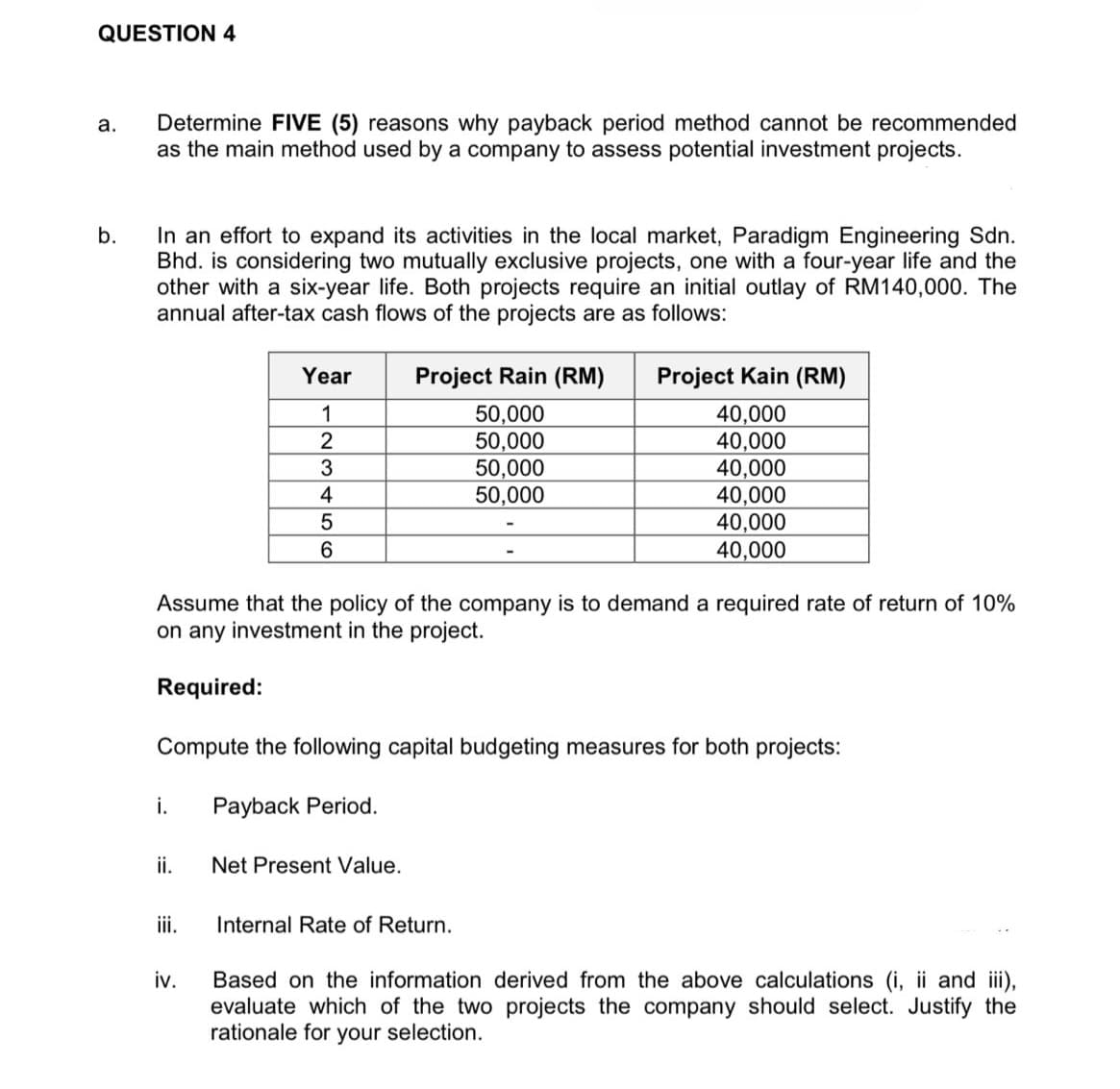Compute the following capital budgeting measures for both projects: i. Payback Period. ii. Net Present Value. iii. Internal Rate of Return. iv. Based on the information derived from the above calculations (i, ii and ii), evaluate which of the two projects the company should select. Justify the rationale for your selection.
Compute the following capital budgeting measures for both projects: i. Payback Period. ii. Net Present Value. iii. Internal Rate of Return. iv. Based on the information derived from the above calculations (i, ii and ii), evaluate which of the two projects the company should select. Justify the rationale for your selection.
Essentials Of Investments
11th Edition
ISBN:9781260013924
Author:Bodie, Zvi, Kane, Alex, MARCUS, Alan J.
Publisher:Bodie, Zvi, Kane, Alex, MARCUS, Alan J.
Chapter1: Investments: Background And Issues
Section: Chapter Questions
Problem 1PS
Related questions
Question

Transcribed Image Text:QUESTION 4
Determine FIVE (5) reasons why payback period method cannot be recommended
as the main method used by a company to assess potential investment projects.
а.
In an effort to expand its activities in the local market, Paradigm Engineering Sdn.
Bhd. is considering two mutually exclusive projects, one with a four-year life and the
other with a six-year life. Both projects require an initial outlay of RM140,000. The
annual after-tax cash flows of the projects are as follows:
b.
Year
Project Rain (RM)
Project Kain (RM)
50,000
50,000
50,000
50,000
40,000
40,000
40,000
40,000
40,000
40,000
1
2
3
4
6.
Assume that the policy of the company is to demand a required rate of return of 10%
on any investment in the project.
Required:
Compute the following capital budgeting measures for both projects:
i.
Payback Period.
ii.
Net Present Value.
iii.
Internal Rate of Return.
iv.
Based on the information derived from the above calculations (i, ii and ii),
evaluate which of the two projects the company should select. Justify the
rationale for your selection.
Expert Solution
This question has been solved!
Explore an expertly crafted, step-by-step solution for a thorough understanding of key concepts.
Step by step
Solved in 5 steps with 1 images

Knowledge Booster
Learn more about
Need a deep-dive on the concept behind this application? Look no further. Learn more about this topic, finance and related others by exploring similar questions and additional content below.Recommended textbooks for you

Essentials Of Investments
Finance
ISBN:
9781260013924
Author:
Bodie, Zvi, Kane, Alex, MARCUS, Alan J.
Publisher:
Mcgraw-hill Education,



Essentials Of Investments
Finance
ISBN:
9781260013924
Author:
Bodie, Zvi, Kane, Alex, MARCUS, Alan J.
Publisher:
Mcgraw-hill Education,



Foundations Of Finance
Finance
ISBN:
9780134897264
Author:
KEOWN, Arthur J., Martin, John D., PETTY, J. William
Publisher:
Pearson,

Fundamentals of Financial Management (MindTap Cou…
Finance
ISBN:
9781337395250
Author:
Eugene F. Brigham, Joel F. Houston
Publisher:
Cengage Learning

Corporate Finance (The Mcgraw-hill/Irwin Series i…
Finance
ISBN:
9780077861759
Author:
Stephen A. Ross Franco Modigliani Professor of Financial Economics Professor, Randolph W Westerfield Robert R. Dockson Deans Chair in Bus. Admin., Jeffrey Jaffe, Bradford D Jordan Professor
Publisher:
McGraw-Hill Education